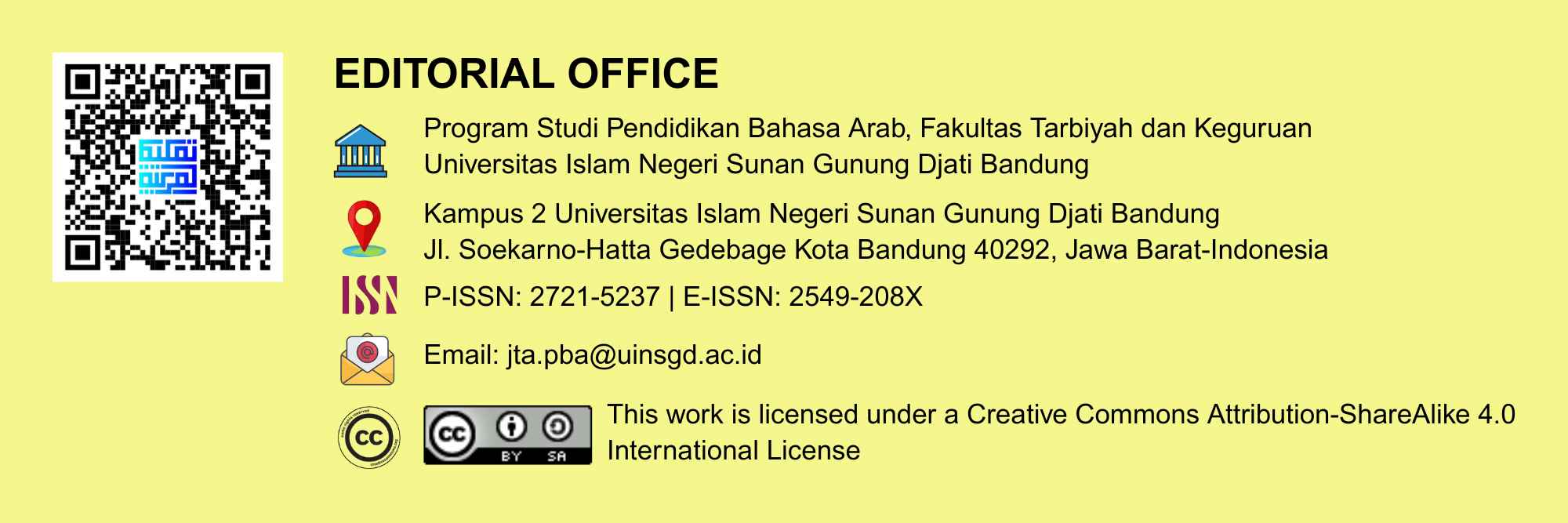Investigating the Validity and Reliability of WTC Construct In L2 Arabic: A Case Study
DOI:
https://doi.org/10.15575/jpba.v8i1.35023Keywords:
Willingness to communicate, Learning Arabic as second language, Online communication, InstrumentAbstract
References
Baghaei, P., & Dourakhshan, A. (2012). The Relationship between Willingness to Communicate and Success in Learning English as a Foreign Language. The Modern Journal of Applied Linguistics (MJAL), 4(2). 53-67. Retrieved from https://www.semanticscholar.org/paper/The-relationship-between-willingness-to-communicate-Baghaei-Dourakhshan/dbcf4c3398e9490fe6bad7e516d5dfdf9f0c246b#extracted
Bonett, D. G., & Wright, T. A. (2015). Cronbach’s Alpha Reliability: Interval Estimation, Hypothesis Testing, and Sample Size Planning. Journal of Organizational Behavior, 36(1), 3–15. https://doi.org/10.1002/job.1960
Browne, M. W., & Cudeck, R. (1992). Alternative Ways of Assessing Model Fit. Sociological Methods & Research, 21(2), 230–258. https://doi.org/10.1177/0049124192021002005
Cao, Y. (2011). Investigating Situational Willingness to Communicate within Second Language Classrooms from an Ecological Perspective. System, 39(4), 468–479. https://doi.org/10.1016/j.system.2011.10.016
Cao, Y. K. (2014). A Sociocognitive Perspective on Second Language Classroom Willingness to Communicate. TESOL Quarterly, 48(4), 789–814. https://doi.org/10.1002/tesq.155
Elahi Shirvan, M., Khajavy, G. H., MacIntyre, P. D., & Taherian, T. (2019). A Meta-analysis of L2 Willingness to Communicate and Its Three High-Evidence Correlates. Journal of Psycholinguistic Research, 48(6), 1241–1267. https://doi.org/10.1007/s10936-019-09656-9
Freiermuth, M., & Jarrell, D. (2006). Willingness to Communicate: Can Online Chat Help?. International Journal of Applied Linguistics, 16(2), 189–212. https://doi.org/10.1111/j.1473-4192.2006.00113.x
Jöreskog, K. G., Olsson, U. H., & Wallentin, F. Y. (2016). Confirmatory Factor Analysis (CFA). In K. G. Jöreskog, U. H. Olsson, & F. Y. Wallentin, Multivariate Analysis with LISREL (pp. 283–339). Springer International Publishing. https://doi.org/10.1007/978-3-319-33153-9_7
Kaiser, H. F. (1960). The Application of Electronic Computers to Factor Analysis. Educational and Psychological Measurement, 20(1), 141–151. https://doi.org/10.1177/001316446002000116
Kang, S.-J. (2005). Dynamic Emergence of Situational Willingness to Communicate in A Second Language. System, 33(2), 277–292. https://doi.org/10.1016/j.system.2004.10.004
Kholis, M. N., Habibi, B. Y., Zaenuri, M., & Hasanah, L. Q. (2023). Willingness to Communicate (WTC) in Arabic for Students of State Islamic University. Alsinatuna, 9(1), 51–64. https://doi.org/10.28918/alsinatuna.v9i1.2206
Kline, R. B. (2016). Principles and Practice of Structural Equation Modeling (4th ed.). The Guilford Press.
Lee, J. S., & Chen Hsieh, J. (2019). Affective Variables and Willingness to Communicate of EFL Learners in In-Class, Out-Of-Class, and Digital Contexts. System, 82, 63–73. https://doi.org/10.1016/j.system.2019.03.002
Lee, J. S., & Drajati, N. A. (2020). Willingness to Communicate in Digital and Non-Digital EFL Contexts: Scale Development and Psychometric Testing. Computer Assisted Language Learning, 33(7), 688–707. https://doi.org/10.1080/09588221.2019.1588330
Lee, J. S., & Lu, Y. (2023). L2 Motivational Self System and Willingness to Communicate in The Classroom and Extramural Digital Contexts. Computer Assisted Language Learning, 36(1–2), 126–148. https://doi.org/10.1080/09588221.2021.1901746
MacCallum, R. C., Widaman, K. F., Preacher, K. J., & Hong, S. (2001). Sample Size in Factor Analysis: The Role of Model Error. Multivariate Behavioral Research, 36(4), 611–637. https://doi.org/10.1207/S15327906MBR3604_06
Macintyre, P. D., Clément, R., Dörnyei, Z., & Noels, K. A. (1998). Conceptualizing Willingness to Communicate in a L2: A Situational Model of L2 Confidence and Affiliation. The Modern Language Journal, 82(4), 545–562. https://doi.org/10.1111/j.1540-4781.1998.tb05543.x
Mahmoodi, M.-H., & Moazam, I. (2014). Willingness to Communicate (WTC) and L2 Achievement: The Case of Arabic Language Learners. Procedia - Social and Behavioral Sciences, 98, 1069–1076. https://doi.org/10.1016/j.sbspro.2014.03.518
McCroskey, J. C., & Baer, J. E. (1985). Willingness to Communicate: The Construct and its Measurement. Paper Presented at the Annual Convention of the Speech Communication Association. https://files.eric.ed.gov/fulltext/ED265604.pdf
Peng, J.-E. (2012). Towards an Ecological Understanding of Willingness to Communicate in EFL Classrooms in China. System, 40(2), 203–213. https://doi.org/10.1016/j.system.2012.02.002
Sürücü, L., Yikilmaz, İ., & Maslakçi, A. (2022). Exploratory Factor Analysis (EFA) in Quantitative Researches and Practical Considerations. World Peace University. https://doi.org/10.31219/osf.io/fgd4e
Taber, K. S. (2018). The Use of Cronbach’s Alpha When Developing and Reporting Research Instruments in Science Education. Research in Science Education, 48(6), 1273–1296. https://doi.org/10.1007/s11165-016-9602-2
Umar, J., & Nisa, Y. F. (2020). Uji Validitas Konstruk dengan CFA dan Pelaporannya. Jurnal Pengukuran Psikologi dan Pendidikan Indonesia (JP3I), 9(2), 1–11. https://doi.org/10.15408/jp3i.v9i2.16964
Watkins, M. W. (2018). Exploratory Factor Analysis: A Guide to Best Practice. Journal of Black Psychology, 44(3), 219–246. https://doi.org/10.1177/0095798418771807
Xia, Y., & Yang, Y. (2019). RMSEA, CFI, and TLI in structural Equation Modeling with Ordered Categorical Data: the Story They Tell Depends on the Estimation Methods. Behavior Research Methods, 51(1), 409–428. https://doi.org/10.3758/s13428-018-1055-2
Zarrinabadi, N. (2014). Communicating in a Second Language: Investigating the Effect of Teacher on Learners’ Willingness to Communicate. System, 42, 288–295. https://doi.org/10.1016/j.system.2013.12.014
Zarrinabadi, N., & Tanbakooei, N. (2016). Willingness to Communicate: Rise, Development, and Some Future Directions. Language and Linguistics Compass, 10(1), 30–45. https://doi.org/10.1111/lnc3.12176
Downloads
Published
How to Cite
Issue
Section
Citation Check
License
Authors who publish in Ta'lim al-'Arabiyyah: Jurnal Pendidikan Bahasa Arab dan Kebahasaaraban agree to the following terms:
- Authors retain copyright and grant the journal right of first publication with the work simultaneously licensed under a Creative Commons Attribution-ShareAlike 4.0 International (CC BY-SA 4.0) License that allows others to share the work with an acknowledgment of the work's authorship and initial publication in this journal.
- Authors are able to enter into separate, additional contractual arrangements for the non-exclusive distribution of the journal's published version of the work (e.g., post it to an institutional repository or publish it in a book), with an acknowledgment of its initial publication in this journal.
- Authors are permitted and encouraged to post their work online (e.g., in institutional repositories or on their website) prior to and during the submission process, as it can lead to productive exchanges, as well as earlier and greater citation of published work (See The Effect of Open Access).
![]()
Ta'lim al-'Arabiyyah: Jurnal Pendidikan Bahasa Arab dan Kebahasaaraban is licensed under a Creative Commons Attribution-ShareAlike 4.0 International License.
Based on a work at https://journal.uinsgd.ac.id/index.php/Talim







